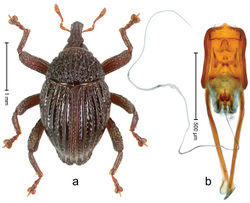Trigonopterus rugosus
| Notice: | This page is derived from the original publication listed below, whose author(s) should always be credited. Further contributors may edit and improve the content of this page and, consequently, need to be credited as well (see page history). Any assessment of factual correctness requires a careful review of the original article as well as of subsequent contributions.
If you are uncertain whether your planned contribution is correct or not, we suggest that you use the associated discussion page instead of editing the page directly. This page should be cited as follows (rationale):
Citation formats to copy and paste
BibTeX: @article{Riedel2014ZooKeys, RIS/ Endnote: TY - JOUR Wikipedia/ Citizendium: <ref name="Riedel2014ZooKeys">{{Citation See also the citation download page at the journal. |
Ordo: Coleoptera
Familia: Curculionidae
Genus: Trigonopterus
Name
Trigonopterus rugosus Riedel sp. n. – Wikispecies link – ZooBank link – Pensoft Profile
Diagnostic description
Holotype, male (Fig. 68a). Length 2.53 mm. Color of antennae and legs ferruginous; head and elytral sutural interval dark ferruginous, remainder black. Body subovate, in dorsal aspect with weak constriction between pronotum and elytron; with distinct constriction in profile. Rostrum with median ridge and pair of submedian ridges, intervening furrows each with sparse row of mesad directed scales; epistome with sinuate transverse ridge. Pronotum without subapical constriction; disk with coarse irregular ridges and tubercles, with sparse, suberect scales. Elytra with striae deeply impressed, each with sparse row of slender, suberect scales; intervals costate, intervals 3 and 5 with row of punctures, others subglabrous; sutural interval basally swollen and widened laterad; suture incised, bordered by rows of suberect scales; elytral apex scabrous, margin subtruncate, with slightly incised suture, with distinct apical denticle. Femora with simple anteroventral ridge, in meso- and metafemur crenate. Metafemur subapically with stridulatory patch. Abdominal ventrite 5 dull, with T-shape ridge along base and middle, coarsely punctate, with sparse erect scales. Penis (Fig. 68b) with sides of body weakly concave; apical edge subangulate, with sparse fringe of setae; apex with median angulate extension; transfer apparatus compact; apodemes 2.0 × as long as body; ductus ejaculatorius without bulbus. Intraspecific variation. Length 2.36–2.53 mm. Color of elytra completely black, with ferruginous sutural interval, or entirely ferruginous. Female rostrum in apical third dorsally subglabrous, sparsely punctate; epistome simple. Female elytra ventroapically with pair of laterally flattened denticles, male elytra ventroapically simple. Female abdominal ventrite 5 medially with weak ridge.
Material examined
Holotype (MZB): ARC0586 (EMBL # LM655522), Bali, Bedugul, Mt. Catur, sample 3, S08°15.626', E115°11.354', 1690 m, 07-XI-2007. Paratypes (MZB, SMNK, ZSM): Bali: 3 exx, ARC0587 (EMBL # LM655523), same data as holotype; 3 exx, Bedugul, Mt. Catur, sample 2, S08°15.147', E115°11.323', 1930 m, 07-XI-2007; 3 exx, ARC0571 (EMBL # LM655507), ARC0572 (EMBL # LM655508), Bedugul, Mt. Pohen (= Mt. Tapak = Mt.Keramat), sample 2, S08°16.328', E115°08.360', 1785 m, 01-XI-2007; 2 exx, ARC0573 (EMBL # LM655509), Bedugul, Mt. Pohen (= Mt. Tapak = Mt.Keramat), sample 3, S08°16.386', E115°08.402', 1735 m, 01-XI-2007; 1 ex, ARC0574 (EMBL # LM655510), Bedugul, Mt. Pohen (= Mt. Tapak = Mt.Keramat), sample 5, S08°16.526', E115°08.634', 1580 m, 01-XI-2007; 1 ex Bedugul, Mt. Pohen (= Mt. Tapak = Mt.Keramat), sample 6, S08°16.607', E115°08.773', 1460 m, 01-XI-07; 4 exx, ARC0591 (EMBL # LM655527), ARC0592 (EMBL # LM655528), ARC0593 (EMBL # LM655529), ARC0594 (EMBL # LM655530), Kintamani, Mt. Abang, sample 1, S08°17.118', E115°24.868', 1440 m, 09-XI-2007, 01-XI-2007; 6 exx, ARC2317 (EMBL # LM655770), ARC2318 (EMBL # LM655771), Angseri, Mt. Adeng, sample 3, S08°19.626', E115°08.554', 1385 m, 06-IV-2011; 5 exx, Angseri, Mt. Adeng, sample 4, S08°19.463', E115°08.537', 1535 m, 06-IV-2011; 9 exx, Angseri, Mt. Adeng, sample 5, S08°19.402', E115°08.545', 1590 m, 06-IV-2011; 5 exx, ARC2321 (EMBL # LM655774), ARC2322 (EMBL # LM655775), Angseri, Mt. Adeng, sample 6, S08°19.138', E115°08.416', 1760 m, 06-IV-2011; 1 female, Bedugul, mountain NW of botanical garden, 1400 m, 04-XII-2004 (ARC).
Distribution
Bali (Mt. Andeng, Bedugul, Kintamani). Elevation: 1385–1785 m.
Etymology
This epithet is based on the Latin adjective rugosus and refers to the wrinkled integument.
Notes
Trigonopterus rugosus Riedel, sp. n. was coded as “Trigonopterus sp. 280” by Tänzler et al. (2014)[1]. The minimal p-distances of cox1 to Trigonopterus pararugosus Riedel, sp. n. is 5.6–7.2%. Morphologically no clear differences could be detected and it is assumed that both represent a pair of cryptic species.
Original Description
- Riedel, A; Tänzler, R; Balke, M; Rahmadi, C; Suhardjono, Y; 2014: Ninety-eight new species of Trigonopterus weevils from Sundaland and the Lesser Sunda Islands ZooKeys, (467): 1-162. doi
Images
|
Other References
- ↑ Tänzler R, Toussaint E, Suhardjono Y, Balke M, Riedel A (2014) Multiple transgressions of Wallace’s Line explain diversity of flightless Trigonopterus weevils on Bali. Proceedings of the Royal Society B: Biological Sciences 281: 20132528. doi: 10.1098/rspb.2013.2528
